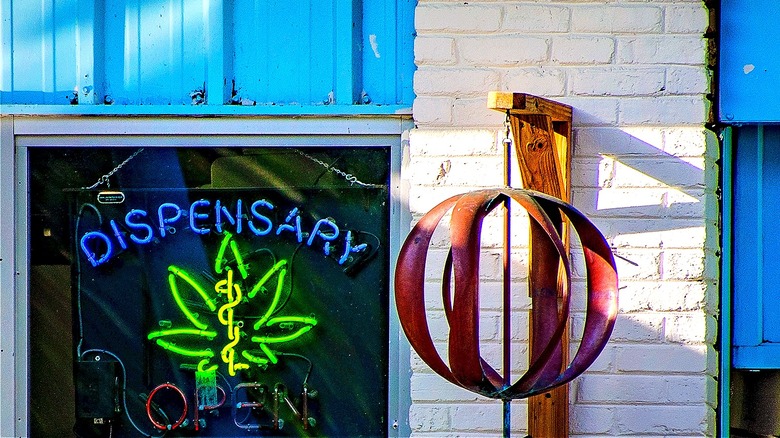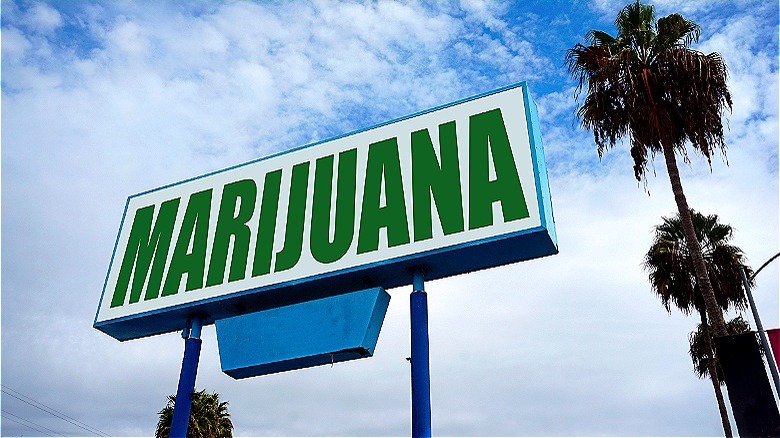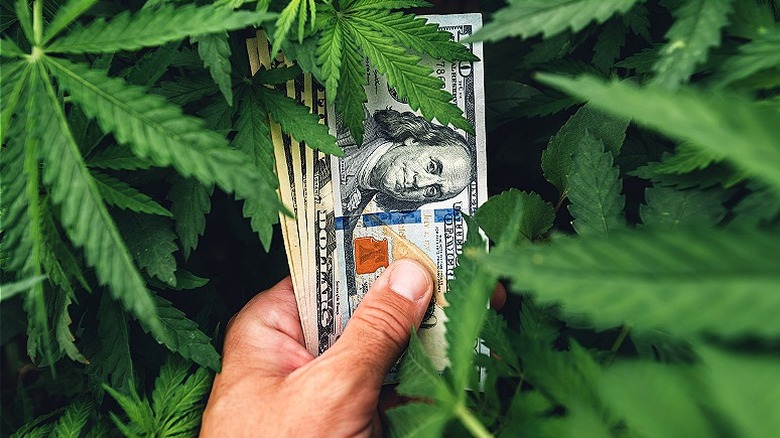States With The Highest Marijuana Revenue In The US
While California was technically the first U.S. state to legalize medical marijuana back in 1996, Colorado and Washington were the first states to legalize recreational marijuana in 2012. Colorado continued to blaze trails when they opened the country's first ever dispensary allowing for the sale of regulated recreational marijuana in January 2014, with Washington state soon behind, opening its dispensaries in July of the same year. Since then, more and more states have joined in, bringing the current total of states with legalized recreational marijuana, as of March 2024, to 24 states (plus the District of Columbia), along with 14 states with legal medicinal marijuana (also, legal or not, it's among the things to keep out of your safe deposit box).
According to the Pew Research Center, 74% of Americans live in a state where marijuana is legal (either recreationally or medicinally), while 79% live in a county with at least one dispensary. The think tank estimates that there are almost 15,000 cannabis dispensaries across the United States, but certain states have significantly more than others. These dispensaries can be moneymakers for states, with combined state numbers reporting $17.5 billion in tax revenue in 2020 from both recreational and medical marijuana sales.
The way each state chooses to tax marijuana can change just how profitable the industry is for the state, and it's also important to realize that the lag time between when voters might approve a new law legalizing marijuana use and when retail dispensaries might actually open is largely due to how individual states choose to create the infrastructure and tax rates associated with the new industry.
States with the highest marijuana revenue
It should come as no surprise that the state with the highest marijuana revenue is also the state with the most dispensaries. As of February 2024, California had 3,659 marijuana dispensaries, more than double the amount of the next highest state. In fact, a quarter of all dispensaries in the entire country are located in California, with Los Angeles County containing more dispensaries than any other state besides California (with 1,481). California earned $1,082,452,368 in marijuana revenues in 2023, and has earned a whopping $5,743,848,792 in revenues since legalized retail sales began in 2018.
However, the number of dispensaries in a specific state isn't always an indication of revenue. Some of the highest marijuana revenue-generating states aren't in the top states for number of dispensaries. For instance, other states that reported significant 2023 marijuana revenue include Washington (at $464,496,959), Illinois (at $451,868,765), and Michigan (at $290,300,000). However, technically, Oklahoma actually has the most marijuana dispensaries per capita in the country and the second-highest number of dispensaries after California. The state boasts 36 dispensaries for every 100,000 residents despite the fact the state currently only allows for medical marijuana use. Florida has the third-highest number of dispensaries in the country with 1,233 and also only currently allows for medical marijuana.
How states spend their marijuana revenue
As varied as the individual sales tax rates in each U.S. state are, how a state chooses to spend its revenue from marijuana sales is even more specific. Most states split their marijuana revenues across numerous programs and or departments but it can depend on the state's individual priorities. For instance, California divides its marijuana tax revenues (which is a simple 15% excise tax on cannabis retailers) across regulatory and research costs, environmental programs, public safety, and even anti-drug programs for kids.
However, other states have more complicated taxation and revenue distribution. Colorado, for one, has both a wholesale excise tax (which is 15%), a 15% retail excise tax, as well as the state's general sales tax rate of 2.9%, with all of that specific tax money going straight to the state's marijuana tax cash fund, called MTCF. This money is dedicated to health care research and education, in addition to substance abuse prevention and treatment programs.
Colorado's wholesale tax, on the other hand, goes straight to the state's Building Excellent Schools Today fund, where the first $40 million is earmarked for constructing new schools. Everything else is divided up, with local governments receiving 10% of the revenue while the state takes the other 90%. Within the 90% the state takes, the majority goes to the MTCF, with smaller portions going to the state's general fund, and the state's public school fund. While these are just two examples, most states with marijuana tax revenue have some variations of these kinds of programs and earmarked projects.


